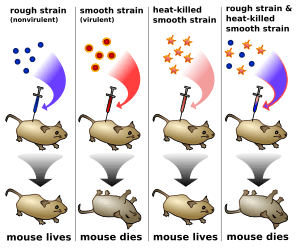Griffith's experiment facts for kids
Griffith's Experiment was a famous experiment done in 1928 by a scientist named Frederick Griffith. It was one of the first times anyone showed that bacteria can pick up DNA from their surroundings. This process is called transformation. It means bacteria can change their traits by getting new genetic material.
Contents
The Bacteria and the Mice
Griffith used two types, or strains, of bacteria called Streptococcus pneumoniae. These bacteria can cause sickness. He tested them on mice, which are often used in experiments because their bodies work in similar ways to humans.
- One type was called III-S (smooth). These bacteria had a special sugar coating, like a shield, around them. This shield protected them from the mouse's immune system. Because of this, the III-S bacteria were very dangerous and would kill the mice.
- The other type was called II-R (rough). These bacteria did not have the protective shield. The mouse's immune system could easily fight them off, so the II-R bacteria were harmless.
What Griffith Did
Griffith did four main steps in his experiment:
Step 1: Live R-strain Bacteria
First, Griffith injected live II-R bacteria into mice.
- The mice stayed healthy. This showed that the II-R strain alone was not harmful.
Step 2: Live S-strain Bacteria
Next, he injected live III-S bacteria into other mice.
- The mice got sick and died. This proved that the III-S strain was deadly.
Step 3: Heat-Killed S-strain Bacteria
Then, Griffith heated the III-S bacteria. This killed them, but their parts were still there. He injected these heat-killed III-S bacteria into mice.
- The mice stayed healthy. This showed that the dead III-S bacteria could not cause sickness on their own.
Step 4: Mixing Dead S-strain and Live R-strain Bacteria
Finally, Griffith mixed the heat-killed III-S bacteria with the live II-R bacteria. He injected this mixture into mice.
- Surprisingly, the mice got sick and died!
What Griffith Found Out
When Griffith looked at the blood of the dead mice from the last step, he found both live II-R bacteria AND live III-S bacteria. This was very puzzling because he had only put live II-R and dead III-S into the mice.
He realized that the harmless II-R bacteria must have changed into the deadly III-S bacteria. He called this change "transformation." He thought there was a "transforming principle" from the dead III-S bacteria that somehow made the live II-R bacteria change.
The "Transforming Principle" is DNA
Today, we know that the "transforming principle" Griffith discovered was actually DNA. Even though the III-S bacteria were killed by heat, their DNA stayed intact.
The live II-R bacteria picked up this DNA from the dead III-S bacteria. The III-S DNA contained the instructions (genes) for making the protective sugar shield. Once the II-R bacteria got these instructions, they could make the shield themselves. This made them dangerous, just like the original III-S strain.
Griffith's experiment was a big step in understanding that DNA carries genetic information. Later experiments by scientists like Avery, MacLeod, and McCarty and Hershey and Chase confirmed that DNA is indeed the molecule that carries genetic traits.
Related pages
- You can find the original paper by Griffith here.
See also
 In Spanish: Experimento de Griffith para niños
In Spanish: Experimento de Griffith para niños


